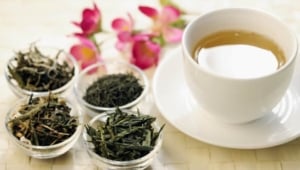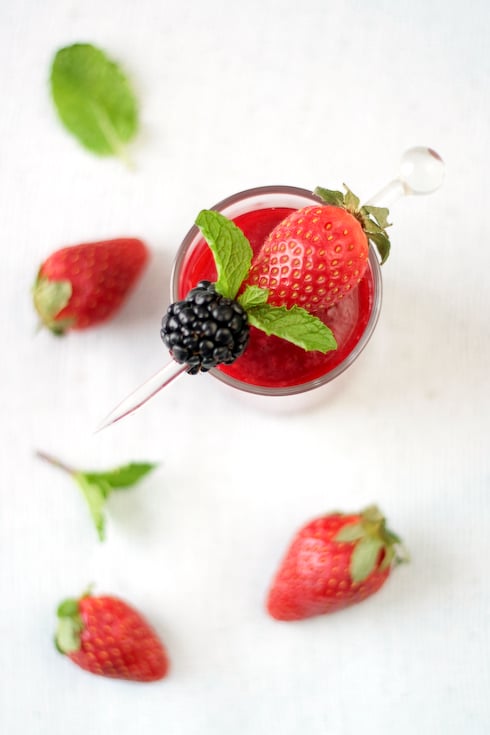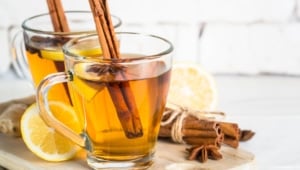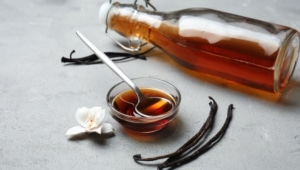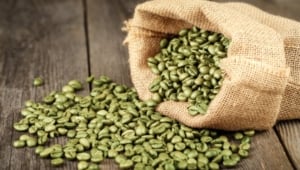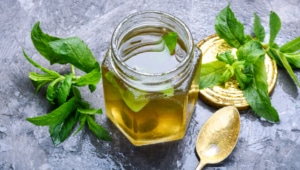5 Health Benefits of Mint Tea & 11 Different Types
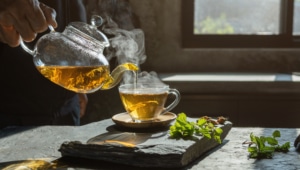
The history of mint tea is a little murky – what we do know is that it was probably first enjoyed in and around Morocco. From there, mint-infused green tea was popularized across Algeria, Libya, Tunisia, and Egypt. Find here all health benefits of mint tea and potential risks.
Mint tea offers a variety of benefits, from helping with indigestion and gastrointestinal symptoms to being a type of natural pain relief. It’s a great tea for detoxifying your body and helping you with weight loss.
There’s much more to mint tea still. In this article, we’ll walk you through everything that’s great about it, as well as any potential side effects.
Interesting Facts about Mint Tea

Interesting Facts about Mint Tea
Mint tea is one of the most widely enjoyed types of tea in the world. There are plenty of interesting facts around the use of mint, its history, and even its spiritual meaning.
For instance, the color is said to denote ‘harmony, peace, and love’ in some cultures. The herb is even mentioned in the Bible. Below are many more interesting facts about mint, its origins, and the different types.
Origin and Where Mint Tea Comes From

Origin and Where Mint Tea Comes From
Mint tea finds its origins in the Greater Maghreb region, which includes Mauritania, Tunisia, Libya, Morocco, and Algeria.
It’s also popular amongst nomadic tribes in the region and beyond. It’s an integral part of life for people in the area, where mint tea is served as a sign of hospitality.
It was also widely planted and used in Algeria in the early 1800s, as it was said to prevent and cure cholera, which was widespread during this time.
As such, mint tea has been brewed both for its enjoyment as well as to prevent all manner of ailments for hundreds of years.
Ingredients in Mint Tea

Ingredients in Mint Tea
There are many varieties of mint tea available today. Traditionally, Maghrebi mint tea is brewed using native spearmint. Moroccan mint tea is often mixed with other herbs and flowers.
Warming herbs such as wormwood and pennyroyal mint are added during the colder seasons, while things like orange blossom water are sometimes added for flavoring.
Some mint tea is also served as a mix with green tea, which adds earthy flavors as well as a kick of caffeine.
Modern mint tea is usually available in dried form either as loose leaf or bagged tea. You can also brew it from fresh sprigs and leaves of mint tea, however, which makes it a great option for growing at home.
Difference between Mint and Peppermint Tea

Difference between Mint and Peppermint Tea
Most mint tea is in fact made from peppermint. Traditional Maghrebi mint tea is made using spearmint leaves.
Peppermint is known to have a higher concentration of menthol than spearmint, making it a little ‘cooler’ in taste than spearmint.
You can combine both peppermint and spearmint to make ‘double mint’ tea, which some people favor.
Find here the best recipes for loaded tea.
Types of Mint Tea

Types of Mint Tea
The most common types of mint found in tea are peppermint and spearmint. But did you know that there are several other types of mint tea you can buy and make? Here we look into the most popular (and obscure) types of mint tea.
Moroccan Mint Tea

Moroccan Mint Tea
Moroccan mint tea is the original type of mint tea from the Greater Maghreb region. It’s typically made from locally grown spearmint, renowned for its fresh, clear flavors. Spearmint is also said to be good for reducing stress and promoting relaxation.
Peppermint Tea

Peppermint Tea
Peppermint tea includes more menthol than spearmint, making it even better at freshening your breath and improving digestion.
It tastes a little ‘cooler’ and is therefore more refreshing. This also makes peppermint a good option for iced tea.
Are you interested in a green tea shot? Here you’ll find tips and recipes.
Double Mint Tea

Double Mint Tea
Double mint tea is essentially just spearmint and peppermint mixed together. Alternatively, you can get a plant called double mint, which is a hybrid of spearmint and wild mint.
It’s also known as red stem apple mint, and works very well in homemade teas and even fruit pies.
Field Mint or Wild Mint Tea
Field mint tastes similar to peppermint, only it’s a little more mild with a less peppery flavor. Field mind tends to be found in fields, as the name suggests.
It’s another great tea choice for counteracting digestive issues, allergies, colds and flu. It’s not known whether wild mint is safe for consumption during pregnancy.
Water Mint Tea

Water Mint Tea
Water mint is much like field mint, but (as the name suggests as well) it grows along waterways like ponds, streams, and marshes. It’s great in teas as well as jellies, salads, and syrups.
The little pink-purple flowers are good to eat. You may wish to steer clear of water mint during pregnancy.
Chocolate Mint Tea
Chocolate mint tastes and smells just like mint chocolates. It’s great for flavoring desserts and making chocolatey mint tea — minus the calories of real chocolate. Chocolate mint is also said to help aid digestion.
Lemon Mint Tea

Lemon Mint Tea
Lemon mint has a lemony fresh flavor. It’s great for adding to desserts, lemonades, and cocktails. You can also add lemon mint to tea to make a beautiful hot beverage. Note: lemon mint is not the same as lemon balm, though they do look similar.
Apple Mint Tea
Apple mint is a fun herb to grow at home. It’s useful for teas, but also great for adding to sorbets, desserts, and even salads. Apple mint is a popular addition to Middle Eastern and Mediterranean dishes. It’s also very good added to cocktails and iced teas.
Mint and Ginger Tea

Mint and Ginger Tea
Mint and ginger tea is made using a mix of both mint leaves and chunks of fresh ginger. It’s said to help with the reduction of stress, promote good digestion, and eliminate toxins in the body.
Ginger also helps with nausea caused by the condition vertigo. It’s a popular choice amongst pregnant women though you should be careful with amounts, as too much ginger may promote bleeding.
Green Tea with Mint

Green Tea with Mint
Green tea blended with mint is a popular choice for those wishing to add lots of beneficial herbs to their diet. The benefits of consuming mint are widely known and explained in this article.
Meanwhile green tea contains healthy polyphenols, which help with digestion, and safeguard against cancers, diabetes, neurodegenerative diseases, and cardiovascular problems.
Lemon Balm and Sage
Lemon balm and sage are members of the mint family, so they offer some similar benefits. Herbal teas made with lemon balm or sage are naturally free from caffeine.
They may help combat a sore throat, and help fight anxiety. Please bear in mind that sage has been linked to high blood pressure and miscarriage, so you should avoid it if pregnant or if you have certain health conditions.
Lemon balm hasn’t been studied in pregnancy.
Nutritional Facts and Calories of Mint Tea

Nutritional Facts and Calories of Mint Tea
Traditionally infused mint tea with no added sugars has around two calories per cup. It offers little in the way of nutrition beyond a few minerals and vitamins present in the plants.
However the flavors and scent make mint tea an enjoyable drink for dieting purposes.
Mint tea is said to encourage digestion while adding minimal additional calories to your diet. This makes it a mildly nutritious beverage that won’t cause any weight gain.
Health Benefits of Drinking Mint Tea: Why It Is So Good for You

Health Benefits of Drinking Mint Tea: Why It Is So Good for You
As we’ve already mentioned, mint tea doesn’t add any calories to your diet and offers some minerals and vitamins if you’re brewing it from fresh sprigs. However, the benefits don’t stop there, and you’ll find plenty more reasons to make mint tea an integral part of your diet below.
Mint Tea Helps With Indigestion
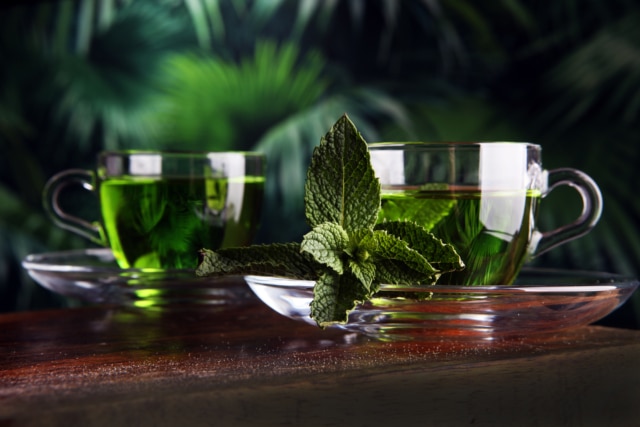
Mint Tea Helps With Indigestion
Mint tea is great for those who suffer from frequent digestive troubles, as it’s said to increase and ease digestion. As such, it may also help with symptoms of IBS and even weight loss.
Mint tea plays a beneficial role in keeping your digestive system intact. It’s a great addition to any diet, particularly following meals.
Mint Tea Helps With Bad Breath

Mint Tea Helps With Bad Breath
It’s widely known that mint toothpaste and mint mouthwash help prevent and alleviate bad breath. As such, mint tea is also beneficial at keeping your breath smelling clean.
This gives you just one more reason to add mint tea to your post-meal repertoire. It doesn’t just aid digestion, but also bad breath.
Find here health benefits of almond milk.
Mint Tea Offers an Alternative to Some Medicine

Mint Tea Offers an Alternative to Some Medicine
This isn’t a proven fact, but mint tea is said to offer some relief for allergy and pain sufferers.
If you have a particularly bad headache or hay fever symptoms, try brewing a cup of mint tea. Mint tea is great for hydrating the body so, if nothing else, it will help by getting more water into your system.
Mint Tea Promotes Relaxation

Mint Tea Promotes Relaxation
In some parts of South America, spearmint tea is used to help ward off stress and fight insomnia.
A study on rats even showed that it helped improve restful sleep and decrease symptoms of anxiety. Spearmint is a relatively mild tea, so adding it to your dietary routine is a great option for most people.
Mint Tea Fights Symptoms of Cold and Flu
Mint tea is helpful at fighting symptoms of cold, coughs, and flu. The menthol in mint tea helps loosen phlegm and thin down mucus. This makes breathing easier and aids in the expulsion of nasties when you sneeze or cough.
Potential Risks of Mint Tea

Potential Risks of Mint Tea
With all the great benefits mint teas have to offer, you may think it’s a safe choice for everyone. For the most part this is true, however there are a few contraindications you’ll want to be aware of.
Mint Tea May Cause Stomach Upset

Mint Tea May Cause Stomach Upset
Since mint tea encourages your digestive system to work harder, it may cause some stomach upset. In some people this translates to heartburn or even diarrhea.
If this is the case for you, try to limit your intake of mint tea and have it alongside or after food only.
Mint Tea May Interact with Your Medication
Mint tea can cause adverse reactions when taken alongside medications such as blood thinners, heart medicine, and antacids. If you’re on any of these types of medicine, you’d best speak to your doctor before consuming mint tea.
Too Much Mint Tea Should be Avoided in Pregnancy

Too Much Mint Tea Should be Avoided in Pregnancy
We’ll tell you more on this topic, but the short of it is that you’ll want to avoid having too much mint tea in pregnancy.
If you’re at all concerned, speak to your doctor before consuming any type of herbal tea.
Herbal teas can have both positive and negative effects, much like milder forms of medicine. Therefore any worries should be communicated to your doctor.
Find here health benefits of oregano.
Is Mint Tea in Pregnancy Good For You?

Is Mint Tea in Pregnancy Good For You?
Peppermint tea is perfectly fine when used in moderate amounts during pregnancy. As it aids digestion, peppermint tea is great for pregnancy-related digestive issues such as flatulence and nausea.
Bear in mind that many herbal teas and spices should potentially be avoided in the first trimester of pregnancy.
Some, including mint tea when consumed in large amounts, can promote bleeding, which you’ll obviously want to stay away from.
Interestingly, you should avoid spearmint specifically in pregnancy as large doses may have adverse effects. Regular peppermint tea is fine, just have it in moderation.
Simple Recipe for Homemade Mint Tea

Simple Recipe for Homemade Mint Tea
All you need to make fresh mint tea at home are 2-3 ingredients: fresh mint, honey, and lemon.
- Start by taking leaves off your chosen sprigs of mint. Rinse under cold water, then gently crush the leaves together to release the menthol.
- Drop the mint leaves in a cafetiere or teapot and top with boiling water.
- Let the tea infuse for around 2-3 minutes. You’ll see that it’s done when the water takes on a slightly green or pale yellow color.
- Strain the tea into cups of heat-proof glasses. Add honey and/or lemon to taste and enjoy while hot.
Tips for Mint Tea

Tips for Mint Tea
Have we convinced you on the many benefits of adding mint tea to your diet? Then you’ll probably want to know how to brew the perfect cup at home. Below are some of our top tips for making delicious mint tea.
Use Ingredients like Honey and Citrus

Use Ingredients like Honey and Citrus
You can sweeten your homemade mint tea with honey or coconut sugar for a delicious, sweet treat. You may also flavor your tea using citrus fruits or floral extracts such as orange water.
Experiment with what works best. For example, homemade blends using organic garden ingredients such as mint, lavender, and rose petals make for great night time drinks.
Grow Your Own Mint

Grow Your Own Mint
On that note, growing your own mint in a garden or in containers can be great fun. You’ll be able to experiment with less readily available types of mint such as chocolate, apple, or even pineapple mint.
Bear in mind that mint can grow very quickly, so you’ll want to make sure it doesn’t overtake your entire garden.
Make Iced Mint Tea with Fruit and Flowers

Make Iced Mint Tea with Fruit and Flowers
Nothing is quite as refreshing and delightful as homemade iced tea.
Homemade mint iced tea offers the benefits of regular iced tea without the added caffeine kick. It’s a lovely relaxing afternoon treat.
Add fresh fruit and unsprayed edible flowers for extra flavoring.
- McFlurry Flavors. Best Flavors & Alternatives.
- Oreo Cookie Flavors. Best and Weirdest Flavors.
- Starbucks Refresher. Tips and Best Drinks.
- Jelly Belly Flavors. Best and Grossest.
- Boba Flavors. Best Flavors and Types.
- Pop Tart Flavors. Tasty Alternatives and Best Flavors.
